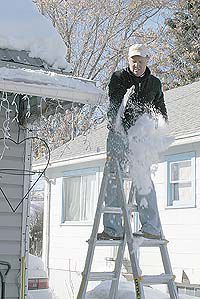| Safety should be the main priority when removing snow from a roof whether it be a business or a residence. |
From Helper to Ferron, property owners have been having problems this winter with snow and ice building up on their roofs.
And for some the results have been disastrous. Collapsed awnings, carports and even the roof of a commercial building in Helper have been the result of many weeks of snow, with little melting or ice buildup when it has melted from the friendly sun or from poorly insulated structures.
Removing the snow from a roof that is either sagging or threatens to do so is dangerous work. The least danger that most people face is not the actual collapse while removing snow, but the various other accidents that happen in relation to the removal.
Roof structures may collapse due to snow or ice, particularly if the load is unevenly distributed on a roof. Heavy snow and ice loads accumulate easily between, for instance, adjacent ridges or arch roofs. It is also a huge problem on flat roofed homes and buildings.
Although snow and ice loads are typically the largest in early March, they may accumulate at any time during winter, depending on weather conditions. And in the Castle Valley the weather has been just right for it in the last two months. Large storms with very small short periods of sun in between has created some of the heaviest snow loads seen in the area for a long time.
While a visual examination can reveal an endangered roof, a dented roof structure implies there is an imminent danger. Warehouses, sheds and light-structure roofs especially should be inspected on a regular basis, and snow loads must be removed if necessary.
Removing snow evenly from the different parts of the roof is a good idea. If workers remove snow from a ridge or arch roof, an equal amount of load should be removed from both sides of the roof. Do not pile snow from upper roofs on lower roofs.
When working on roofs to remove snow always follow the relevant safety regulations to avoid the danger of falling, and always remember to wear a safety harness. Especially during warmer days snow may suddenly start to slide from the roof in large quantities.
Many people do things like taking snowblowers on roofs and scraping the snow right down to the roofing structure. Neither of these should be done. Avoid damaging the roofing by leaving a thin layer of snow on the roof.
The removal of snow from a roof doesn’t only constitute a danger to those doing the work, but also to the passers-by. Prevent snow and ice accumulation on roofs, structures and equipment from falling off the roof and possibly onto people.
For some, snow on trees is also a problem because of the possibility they could break from the weight.
Don’t attempt to remove snow from a tree that has bent over a power line, or from cables, and do not fell a tree that has been damaged by snow close to a power line since this may risk the life of everyone around. If you notice any danger, contact the local power provider.
It is also a good idea to check that summer houses and other dwellings that are not permanently occupied for snow load as well.
For those that own rentals, or business buildings greater duty of care also applies to risks arising from snow and ice accumulated on roofs.
This means that, in the event of damage, the owner or holder must be able to prove that everything possible had been done to prevent damage from occurring to clients property. Outsourcing of the daily real estate maintenance duties to an external maintenance company does not free the real estate owner or holder from liability towards a third party suffering loss, damage or injury. From the viewpoint of liability risk management, it is important that the tasks and responsibilities of the maintenance company are defined in detail and unambiguously in the real estate maintenance contract.
In the event of an accident, negligence in maintenance may result in punitive sanctions, in addition to the liability for damages.

